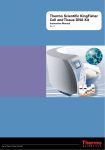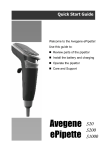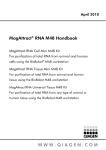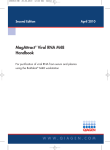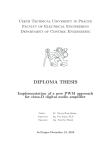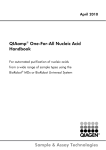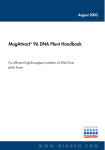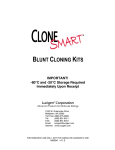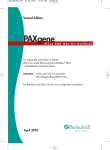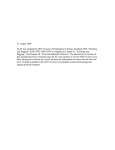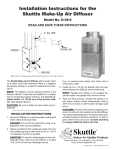Download MagAttract® DNA Mini M48 Handbook
Transcript
Second Edition December April 2012 2005 MagAttract ® DNA Mini M48 Handbook MagAttract DNA Mini M48 Kit For DNA purification from soft tissues and cultured cells using the BioRobot ® M48 workstation Sample & Assay Technologies QIAGEN Sample and Assay Technologies QIAGEN is the leading provider of innovative sample and assay technologies, enabling the isolation and detection of contents of any biological sample. Our advanced, high-quality products and services ensure success from sample to result. QIAGEN sets standards in: I I I I Purification of DNA, RNA, and proteins Nucleic acid and protein assays microRNA research and RNAi Automation of sample and assay technologies Our mission is to enable you to achieve outstanding success and breakthroughs. For more information, visit www.qiagen.com. Contents Kit Contents 4 Storage 4 Intended Use 4 Safety Information 4 Quality Control 5 Introduction 5 Principle and procedure 5 Starting material 5 Yield of purified DNA 7 Supplementary MagAttract M48 protocols for additional sample types 8 Equipment and Reagents to Be Supplied by User Important Notes 9 10 Lysis with proteinase K 10 Buffer MTL 10 Buffer MW1 10 MagAttract Suspension B 10 Residual reagents 10 Quantification of DNA 10 Protocols Purification of Total DNA from Soft Tissues using the MagAttract DNA Mini M48 Kit 11 Purification of Total DNA from Mouse Tail Tissue using the MagAttract DNA Mini M48 Kit 13 Purification of Total DNA from Cultured Cells using the MagAttract DNA Mini M48 Kit 15 Troubleshooting Guide 17 Appendix: Storage, Quantification, and Determination of Purity of DNA 20 Ordering Information 21 MagAttract DNA Mini M48 Handbook 04/2012 3 Kit Contents MagAttract DNA Mini M48 Kit Catalog no. Preps per kit MagAttract Suspension B (192) 953336 192 2 x 10 ml Buffer MTL 3 x 54 ml Buffer MW1 2 x 77 ml Buffer MW2 87 ml RNase-free water 2 x 50 ml Buffer G2 70 ml QIAGEN® Proteinase K 2.0 ml Quick-Start Protocol 1 Storage All buffers and reagents should be stored at room temperature (15–25°C). The ready-to-use QIAGEN Proteinase K solution is stable for up to one year after delivery when stored at room temperature. To prolong the lifetime of QIAGEN Proteinase K, storage at 2–8°C is recommended. Intended Use The MagAttract DNA Mini M48 Kit is intended for molecular biology applications. This product is not intended for the diagnosis, prevention, or treatment of a disease. Safety Information When working with chemicals, always wear a suitable lab coat, disposable gloves, and protective goggles. For more information, please consult the appropriate material safety data sheets (MSDSs). These are available online in convenient and compact PDF format at www.qiagen.com/ts/msds.asp where you can find, view, and print the MSDS for each QIAGEN kit and kit component. CAUTION: DO NOT add bleach or acidic solutions directly to the sample-preparation waste. Buffers MW1 and MTL contain guanidine hydrochloride/guanidine thiocyanate, which can form highly reactive compounds when combined with bleach. If liquid containing these buffers is spilt, clean with suitable laboratory detergent and water. If the spilt liquid contains potentially infectious agents, clean the affected area first 4 MagAttract DNA Mini M48 Handbook 04/2012 with laboratory detergent and water, and then with 1% (v/v) sodium hypochlorite. If liquid containing potentially infectious agents is spilt on the BioRobot M48, clean the affected area first with laboratory detergent and water, and then with 1% (v/v) sodium hypochlorite, followed by water. 24-hour emergency information Emergency medical information in English, French, and German can be obtained 24 hours a day from: Poison Information Center Mainz, Germany. Tel: +49-6131-19240 Quality Control In accordance with QIAGEN’s ISO-certified Total Quality Management System, each lot of MagAttract DNA Mini M48 Kits is tested against predetermined specifications to ensure consistent product quality. Introduction The MagAttract DNA M48 Mini Kit is designed for automated purification of total DNA from soft-tissue biopsies and cultured cells. MagAttract technology provides high-quality DNA, which is suitable for direct use in downstream applications, such as amplification or other enzymatic reactions. The BioRobot M48 performs all steps of the sample preparation procedure, and the procedure can be scaled up or down, allowing purification from varying amounts of starting material. Principle and procedure MagAttract technology combines the speed and efficiency of silica-based DNA purification with the convenient handling of magnetic particles. Some protocols require short pre-treatment steps (for example, tissue samples require a proteinase K digestion). DNA binds to the silica surface of the magnetic particles in the presence of a chaotropic salt (see flowchart, page 6). DNA bound to the magnetic particles is then efficiently washed. Two different wash buffers are used, followed by a rapid rinse with distilled water, which considerably improves the purity of the DNA. High-quality DNA is eluted in the water provided. DNA yields depend on sample type and storage. Starting material The amounts of starting material for use in MagAttract DNA Mini M48 procedures are shown in Table 1 on page 7. The sample and elution volumes for each protocol can be scaled within the ranges shown to give a yield and concentration of high-quality DNA appropriate for the intended downstream application. Fresh or frozen mouse tail biopsies are a rich source of genomic DNA. Biopsies harvested from the tail tip often result in higher yields per millimeter tail (or milligram MagAttract DNA Mini M48 Handbook 04/2012 5 tissue) than biopsies from higher up the tail. If mouse tail biopsy samples are not to be processed immediately after collection, storage at –20°C or –70°C is recommended. Both fresh and frozen cultured cells may be used with the cultured cell protocol. The recommended amount of starting material to use is 2 x 106 cells. Frozen cell pellets should be resuspended in Buffer G2, as described in the protocol. The MagAttract DNA Mini M48 Procedure Digested tissue or cultured cells Lyse with Buffer MTL MagAttract Suspension B added to samples DNA binds to magnetic particles Magnetic separation Magnet Wash Magnetic separation Magnet Elute Pure, high-quality DNA 6 MagAttract DNA Mini M48 Handbook 04/2012 Table 1. Starting materials, elution volumes, and protocol times used in MagAttract DNA Mini M48 procedures Sample type Sample volume Elution volume (µl) (µl) Protocol Setup and pretreat- Run time ment (min) (min)* Protocols on the App. Package, M48, Genomic Research Soft tissues 10–40 mg (see Table 2) 50–200 Tissue 70 min – 16 h 23–159 Mouse tail 200 µl predigested sample 50–200 Tissue 70 min – 16 h 23–159 Cultured cells 200 µl resuspended 50–100 Cultured Cells 10–15 23–159 Protocols on the App. Package, M48, Genetic Screening Dried blood 4 pretreated paper disks 50–400 Dried Blood† 40–75 18–129 Buccal cells 200 µl predigested sample (1 swab in tube) 50–400 Buccal Cells† 40–75 23–159 Paraffin Sections† 50–85 18–130 Protocols on the App. Package, M48, Pathology Paraffinembedded tissues 1–2 10 µm thick sections 75–200 Protocols on the App. Package, M48, Infectious Disease Bacterial cultures Primary samples (bacterial DNA) 200 µl 50–200‡ Bact_200 µl† 10–60 23–160 200 µl § † 10–60 23–160 50–200 Bact_200 µl * Fully automated run times vary depending on the number of samples processed (6–48 samples). † Supplementary protocol; available online at www.qiagen.com/literature/clinlit.asp. ‡ Recommended elution volume 100–200 µl. § Recommended elution volume 100 µl. Yield of purified DNA DNA yields depend on the sample type, number of nucleated cells in the sample, and the protocol used for isolation of DNA. Table 2 shows typical yields obtained from different sample volumes and sample types. Elution in smaller volumes increases the final DNA concentration in the eluate, but slightly reduces overall DNA yield. We recommend using an elution volume appropriate for the intended downstream application. MagAttract DNA Mini M48 Handbook 04/2012 7 Table 2. DNA yields obtained from different sample types using MagAttract DNA Mini M48 procedures Sample type Sample volume DNA yield Skeletal muscle 200 µl (40 mg tissue digested) Up to 9 µg Heart 200 µl (20 mg tissue digested) Up to 12 µg Spleen 200 µl (10 mg tissue digested) Up to 28 µg Lung 200 µl (10 mg tissue digested) Up to 17 µg Kidney 200 µl (10 mg tissue digested) Up to 18 µg Mouse tail biopsies 200 µl (2 mm length section of mouse tail, approximately 12–22 mg) Up to 18 µg HL-60 cells 200 µl (2 x 106 cells) 6–7.5 µg Supplementary MagAttract M48 protocols for additional sample types Supplementary protocols for automated purification of DNA from blood products and other tissue and cell types using the MagAttract DNA M48 System are available online at www.qiagen.com/literature/clinlit.asp. 8 MagAttract DNA Mini M48 Handbook 04/2012 Equipment and Reagents to Be Supplied by User When working with chemicals, always wear a suitable lab coat, disposable gloves, and protective goggles. For more information, consult the appropriate material safety data sheets (MSDSs), available from the product supplier. I I I I I I I I I I I I I I BioRobot M48 workstation (cat. no. 9000708) App. Package, M48, Genomic Research (cat. no. 9016148) Filter-Tips, 1000 µl, M48 (1000), cat. no. 995652 Reagent Containers, small, M48 (100), cat. no. 995902 Reagent Containers, large, M48 (50), cat. no. 995904 Reagent Container Seals, M48 (50), cat. no. 995906 Sample Prep Plates, 42-well, M48 (100), cat. no. 995908 Sample tubes, 1.5 ml, without lids (Sarstedt, cat. no. 72.696)* or with screw caps (Sarstedt, cat. no. 72.692)* Elution tubes with screw caps, 1.5 ml (Sarstedt, cat. no. 72.692)*† or 2.0 ml (Sarstedt, cat. no. 72.693)*† Disposable gloves Pipets and pipet tips Centrifuge for 1.5 ml sample tubes, capable of centrifugation at 300 x g Tissue and mouse tail protocols: Heating block or water bath at 56°C Ethanol (96–100%) Optional: I I Cooling Block, 48-tube, 0.2 ml, M48, cat. no. 9015178 Cooling Block, 48-tube, 1.4 ml, M48, cat. no. 9015180 * This is not a complete list of suppliers and does not include many important vendors of biological supplies; however, use of other tubes may result in an instrument crash. † DNA can also be eluted into 0.2 ml thin-walled PCR tubes or 1.4 ml tubes. MagAttract DNA Mini M48 Handbook 04/2012 9 Important Notes Lysis with proteinase K The MagAttract DNA Mini M48 Kit contains proteinase K, which is the enzyme of choice for lysis buffers used in the tissue protocol. QIAGEN Proteinase K is isolated from the saprophytic fungus Tritirachium album and is particularly suitable for short digestion times. It possesses a high specific activity, which remains stable over a wide range of temperatures and pH values, with substantially increased activity at higher temperatures. The activity of the proteinase K solution is 600 mAU/ml solution (or 40 mAU/mg protein). This activity provides optimal results in MagAttract DNA Mini M48 protocols. Buffer MTL Before use, check that Buffer MTL does not contain a white precipitate by shaking the bottle. Check again when pipetting Buffer MTL into the Reagent Container. If necessary, incubate for 30 minutes at 37°C with occasional shaking to dissolve precipitate. Between runs, store Buffer MTL at room temperature (15–25°C). Buffer MW1 Add 26 ml of ethanol (96–100%) to a bottle containing 77 ml of Buffer MW1 (provided) as described on the bottle. Tick the check box on the bottle to indicate that ethanol has been added. Between runs, store the reconstituted Buffer MW1 at room temperature (15–25°C). Note: Always mix Buffer MW1 by shaking the bottle five times before starting the procedure. MagAttract Suspension B Shake the bottle containing MagAttract Suspension B and vortex for 3 minutes (before first use) or 1 minute (before subsequent uses) to ensure that the magnetic silica particles are fully resuspended. Residual reagents Residual reagents should either be removed immediately from the workstation and transferred to an airtight container, or discarded. Residual Buffer MTL should always be discarded. Quantification of DNA Carryover of magnetic particles may affect the absorbance reading at 260 nm (A260) of the purified DNA but should not affect downstream applications. The measured absorbance at 320 nm (A320) should be subtracted from all absorbance readings. See “Quantification of DNA”, Appendix, page 20 for more information. 10 MagAttract DNA Mini M48 Handbook 04/2012 Protocol: Purification of Total DNA from Soft Tissues using the MagAttract DNA Mini M48 Kit I Supplementary protocols for automated purification of DNA from other sample types using the MagAttract DNA M48 System are available online at www.qiagen.com/literature/clinlit.asp. Things to do before starting I I I Before beginning the procedure, read the Important Notes on page 10. Check that Buffer MW1 has been prepared according to the instructions on page 10. Before use, check that Buffer MTL does not contain a white precipitate by shaking the bottle. Check again when pipetting Buffer MTL into the Reagent Container. If necessary, incubate for 30 minutes at 37°C with occasional shaking to dissolve precipitate. Procedure 1. Transfer tissue into a 1.5 ml sample tube (with screw-cap). For most tissue types, a sample size of 10 mg is recommended; however, for heart up to 20 mg and for muscle up to 40 mg may be used. 2. Add 190 µl Buffer G2. Ensure tissue pieces are fully submerged in Buffer G2. 3. Add 10 µl proteinase K solution and mix by tapping on the tube gently. 4. Incubate at 56°C until the tissue is completely lysed. Vortex 2–3 times per hour during incubation to disperse the sample, or place in a thermomixer, shaking water bath, or on a rocking platform. Lysis time varies depending on the type of tissue processed. Lysis is usually complete in 3 h. Lysis overnight is possible and does not influence the preparation. 5. Homogenize the sample by pipetting up and down several times. Large pieces of insoluble material, which could clog pipette tips, should be removed by a quick centrifugation (300 x g, 1 min). Transfer the supernatant to a new 1.5 ml sample tube. 6. Ensure that the BioRobot M48 is switched on. The power switch is on the left side of the instrument. 7. Switch on the computer and monitor. MagAttract DNA Mini M48 Handbook 04/2012 11 Soft Tissues Important point before starting Soft Tissues 8. Launch the QIAsoft M Operating System if necessary. The computer controlling the BioRobot M48 is normally set to launch the QIAsoft M startup window upon startup, but this setting may have been changed. The QIAsoft M Operating System can also be started from the QIAsoft M icon on the desktop or from the Microsoft® Windows® “Start” menu, under QIAsoft M Operating System → QIAsoft M V2.0 for BioRobot M48. 9. Select the protocol group “Genomic Research” from the drop-down menu, by clicking on the dark green arrow, then select “gDNA”. 10. Select the protocol “Tissue” and click the ”Select” button to choose the elution tube type. Input the number of samples and sample and elution volumes into the software. The QIAsoft M software will now guide you through the remaining steps required to set up the BioRobot M48 for the MagAttract DNA Tissue Protocol; these steps include the option of entering names for your samples. Follow the steps detailed in each protocol message before continuing. Wear gloves when loading the required items on the worktable. 11. Place the sample tubes on the worktable, plus reagent containers and plasticware, according to the software. 12. Close the workstation door and start the purification protocol. All steps are fully automated, and a software message on the screen will indicate when the protocol is finished. 13. Retrieve the elution tubes containing the purified DNA from the cooling block. The DNA is ready to use, or can be stored at 2–8°C for 24 h or at –20°C for longer periods. If the purified DNA is to be analyzed by fluorescent capillary sequencing, the tube containing the eluate should first be applied to a suitable magnetic separator and the eluate transferred to a clean tube to minimize the risk of magneticparticle carryover (see Appendix, page 20). 12 MagAttract DNA Mini M48 Handbook 04/2012 Protocol: Purification of Total DNA from Mouse Tail Tissue using the MagAttract DNA Mini M48 Kit Important point before starting I Supplementary protocols for automated purification of DNA from other sample types using the MagAttract DNA Mini M48 Kit are available online at www.qiagen.com/literture/clinlit.asp. I I I I Before beginning the procedure, read the Important Notes on page 10. Check that Buffer MW1 has been prepared according to the instructions on page 10. Before use, check that Buffer MTL does not contain a white precipitate by shaking the bottle. Check again when pipetting Buffer MTL into the reagent container. If necessary, incubate for 30 minutes at 37°C with occasional shaking to dissolve precipitate. Insoluble material in the digested sample may clog the BioRobot M48 tips. Such material should be removed as described in the procedure below. Procedure 1. Cut a 2 mm length section of mouse tail (approximately 12–22 mg) into a 1.5 ml sample tube with screw cap. At this stage, samples may be frozen (at –20°C or –70°C) for later processing. When processing frozen samples, remove samples from storage and allow to thaw at room temperature (15–25°C) before use. 2. Add 190 µl of Buffer G2 to the sample. Ensure the biopsy sample is fully submerged in Buffer G2. 3. Add 10 µl QIAGEN Proteinase K, and mix by tapping the tube gently. 4. Incubate at 56°C until the tissue is completely lysed. To ensure the sample is mixed thoroughly during incubation, place the sample in a thermomixer, in a shaking water bath, or on a rocking platform. For complete lysis of sample tissue, overnight incubation is often required. 5. Centrifuge the tube briefly to remove drops from inside the lid. 6. Homogenize the sample by pipetting up and down several times. Large pieces of insoluble material, such as undigested cartilage, can clog the BioRobot M48 tips and therefore should be removed. To remove insoluble material centrifuge the sample at 300 x g for 1 min, and transfer the supernatant to a new 1.5 ml sample tube. Undigested hair does not normally influence the purification. MagAttract DNA Mini M48 Handbook 04/2012 13 Mouse Tail Things to do before starting 7. Ensure that the BioRobot M48 is switched on. The power switch is on the left side of the instrument. 8. Switch on the computer and monitor. 9. Launch the QIAsoft M Operating System. Mouse Tail Upon startup, the computer controlling the BioRobot M48 is normally set to launch the QIAsoft M software startup window, but this setting may have been changed. The QIAsoft M Operating System can also be started from the QIAsoft M icon on the desktop or from the Microsoft Windows “Start” menu, where it is located in QIAsoft M Operating System → QIAsoft M V2.0 for BioRobot M48. 10. Select the protocol group “Genomic Research” from the drop-down menu, by clicking on the dark green arrow, then select “gDNA”. 11. Select the protocol “Tissue” and click the “Select” button to choose the elution tube type. Enter the number of samples, and sample and elution volumes into the software. The QIAsoft M software will now guide you through the remaining steps required to set up the BioRobot M48 for the MagAttract DNA Tissue Protocol. Follow the steps detailed in the protocol message before continuing. Wear gloves when loading the required items on the worktable. 12. Place the sample tubes on the worktable, plus reagent containers and plasticware, according to the software. 13. Close the workstation door and start the purification procedure. All steps are fully automated, and a software message on the screen will indicate when the procedure is finished. 14. Retrieve the elution tubes containing the purified DNA from the cooling block. The DNA is ready to use, or can be stored at 2–8°C for 24 h or at –20°C for longer periods. If the purified DNA is to be analyzed by real-time PCR, tubes containing eluate should first be applied to a suitable magnetic separator and the eluate transferred to a clean tube (see Appendix, page 20) to minimize the risk of magnetic-particle carryover. 14 MagAttract DNA Mini M48 Handbook 04/2012 Protocol: Purification of Total DNA from Cultured Cells using the MagAttract DNA Mini M48 Kit Important points before starting I Supplementary protocols for automated purification of DNA from other sample types using the MagAttract DNA Mini M48 Kit are available online at www.qiagen.com/literture/clinlit.asp. Things to do before starting I I Check that Buffer MW1 has been prepared according to the instructions on page 10. Before use, check that Buffer MTL does not contain a white precipitate by shaking the bottle. Check again when pipetting Buffer MTL into the reagent container. If necessary, incubate for 30 minutes at 37°C with occasional shaking to dissolve precipitate. Procedure 1. Centrifuge a maximum of 2 x 106 cells at 300 x g for 5 min in a 1.5 ml sample tube (with screw-cap). Remove and discard the supernatant, taking care not to disturb the cell pellet. At this point cells may be frozen (at –20°C or –70°C) for future use or may be used immediately. 2. Add 200 µl of Buffer G2 to the 1.5 ml sample tube containing approximately 2 x 106 cells. Resuspend the cells thoroughly by pipetting up and down. 3. Ensure that the BioRobot M48 is switched on. The power switch is on the left side of the instrument. 4. 5. Switch on the computer and monitor. Launch the QIAsoft M Operating System. Upon startup, the computer controlling the BioRobot M48 is normally set to launch the QIAsoft M software startup window, but this setting may have been changed. The QIAsoft M Operating System can also be started from the QIAsoft M icon on the desktop or from the Microsoft Windows “Start” menu, where it is located in QIAsoft M Operating System → QIAsoft M V2.0 for BioRobot M48. 6. Select the protocol group “Genomic Research” from the drop-down menu, by clicking on the dark green arrow, then select “gDNA”. MagAttract DNA Mini M48 Handbook 04/2012 15 Cultured Cells I Before beginning the procedure, read the Important Notes on page 10. 7. Select the protocol “Cultured Cells” and click the “Select” button to choose the elution tube type. Enter the number of samples, and sample and elution volumes into the software. Cultured Cells The QIAsoft M software will now guide you through the remaining steps required to set up the BioRobot M48 for the MagAttract DNA Cultured Cells Protocol. Follow the steps detailed in the protocol message before continuing. Wear gloves when loading the required items on the worktable. 8. Place the sample tubes on the worktable, plus reagent containers and plasticware, according to the software. 9. Close the workstation door and start the purification procedure. All steps are fully automated, and a software message on the screen will indicate when the procedure is finished. 10. Retrieve the elution tubes containing the purified DNA from the cooling block. The DNA is ready to use, or can be stored at 2–8°C for 24 h or at –20°C for longer periods. If the purified DNA is to be analyzed by real-time PCR, tubes containing eluate should first be applied to a suitable magnetic separator and the eluate transferred to a clean tube (see Appendix, page 20) to minimize the risk of magnetic-particle carryover. 16 MagAttract DNA Mini M48 Handbook 04/2012 Troubleshooting Guide This troubleshooting guide may be helpful in solving any problems that may arise. The scientists in QIAGEN Technical Services are always happy to answer any questions you may have about either the information and protocols in this handbook or molecular biology applications (see inside front cover for contact information). Comments and suggestions General handling QIAsoft M software error dialog box If the QIAsoft M software displays an error dialog box during a protocol run, refer to the Troubleshooting Guide in the BioRobot M48 User Manual. Low DNA yield a) Incomplete sample lysis Before use, check that Buffer MTL does not contain a white precipitate by shaking the bottle. Check again when pipetting Buffer MTL into the Reagent Container. If necessary, incubate for 30 minutes at 37°C with occasional shaking to dissolve precipitate. b) MagAttract Suspension B was not completely resuspended Before starting the procedure, ensure that the MagAttract Suspension B is fully resuspended. Vortex for at least 3 minutes before first use, and for 1 minute before subsequent uses. c) Buffer MW1 did not contain ethanol Ensure that the correct volume of ethanol was added to Buffer MW1. Repeat the purification procedure with new samples. d) Reagents were loaded onto worktable in wrong order Ensure that all reagents were loaded onto the worktable in the correct order. Repeat the purification procedure with new samples. e) Incomplete digestion of tissue samples Ensure that the tissue is completely digested by extending the time of incubation with proteinase K. MagAttract DNA Mini M48 Handbook 04/2012 17 Comments and suggestions f) Clogging of pipet tip due to insoluble material Insoluble material, such as undigested cartilage, was not removed from the digested sample prior to starting the BioRobot M48 DNA purification procedure. To remove insoluble material centrifuge the sample at 300 x g for 1 minute, as indicated in the protocol, and transfer the supernatant to a new 1.5 ml sample tube. g) Clogging of pipet tip due to sample overload Reduce the sample input volume. h) Mouse tail protocol: Insufficient amount of starting material An insufficient amount of mouse tail may have been used. Biopsies taken from further up the tail (away from the tail tip end) result in lower DNA yields per millimeter (or milligram) tissue. Increase the size of the biopsy up to a maximum length of 2 mm (or 22 mg), and take care to remove any insoluble material prior to DNA purification. DNA does not perform well in downstream applications a) Insufficient DNA used in downstream application Quantify the purified DNA by spectrophotometric measurement of the absorbance at 260 nm, (see “Quantification of DNA”, Appendix, page 20). b) Excess DNA used in downstream application Excess DNA can inhibit some enzymatic reactions. Quantify the purified DNA by spectrophotometric measurement of the absorbance at 260 nm, (see “Quantification of DNA”, Appendix, page 20). c) Degraded DNA obtained from tissue samples Too much sample may have been used. For most sample types, 10 mg tissue is sufficient per 200 µl total reaction volume. 18 MagAttract DNA Mini M48 Handbook 04/2012 Comments and suggestions A260 /A280 ratio for purified DNA is low a) Buffer MW1 did not contain ethanol Ensure that the correct volume of ethanol was added to Buffer MW1. Repeat the purification procedure with new samples. b) Absorbance reading at 320 nm was not subtracted from the absorbance readings at 260 nm and 280 nm To correct for the presence of magnetic particles in the eluate, an absorbance reading at 320 nm should be taken and subtracted from the absorbance readings obtained at 260 nm and 280 nm (see “Quantification of DNA”, Appendix, page 20). MagAttract DNA Mini M48 Handbook 04/2012 19 Appendix: Storage, Quantification, and Determination of Purity of DNA Storage of DNA Purified DNA may be stored at 2–8°C for 24 hours or at –20°C for longer storage. Quantification of DNA The concentration of DNA should be determined by measuring the absorbance at 260 nm (A260) in a spectrophotometer. Absorbance readings at 260 nm should fall between 0.1 and 1.0 to be accurate. An absorbance of 1 unit at 260 nm corresponds to 50 µg of DNA per milliliter (A260 = 1 → 50 µg/ml). Use water to dilute the samples and to calibrate the spectrophotometer. The ratio between the absorbance values at 260 nm and 280 nm gives an estimate of DNA purity (see “Purity of DNA”). Carryover of magnetic particles in the eluate may affect the A260 reading, but should not affect the performance of the DNA in downstream applications. If the purified DNA is to be analyzed by fluorescent capillary sequencing, the tube containing the eluate should first be applied to a suitable magnetic separator and the eluate transferred to a clean tube (see below). To quantify DNA purified using the MagAttract DNA M48 System: I I I I Apply the tube containing the DNA to a suitable magnetic separator (e.g., QIAGEN 12-Tube Magnet, cat. no. 36912) for 1 minute. If a suitable magnetic separator is not available, centrifuge the tube containing the DNA for 1 minute at full speed in a microcentrifuge to pellet any remaining magnetic particles. Once separation is complete, carefully withdraw 10–50 µl of purified DNA and dilute to a final volume of 100 µl in water. Measure the absorbance at 320 nm, 280 nm, and 260 nm. Subtract the absorbance reading obtained at 320 nm from the readings obtained at 260 nm and 280 nm to correct for the presence of magnetic particles. Concentration of DNA sample = 50 µg/ml x (A260 – A320) x dilution factor Total amount of DNA purified = concentration x volume of sample in milliliter Purity of DNA Purity is determined by calculating the ratio of corrected absorbance at 260 nm to corrected absorbance at 280 nm i.e., (A260 – A320)/(A280 – A320). Pure DNA has an A260/A280 ratio of 1.7–1.9. 20 MagAttract DNA Mini M48 Handbook 04/2012 Ordering Information Product Contents Cat. no. MagAttract DNA Mini M48 Kit (192) MagAttract Suspension B and buffers for up to 192 preps 953336 App. Package, M48, Genomic Research Software protocol package for genomic research applications on BioRobot M48 workstation 9016148 BioRobot M48 Robotic workstation for automation of magnetic-particle purification technology 9000708 Starter Pack, M48 Pack includes: sterile filter-tips (600); sample preparation plates (40); large reagent containers (8); small reagent containers (8); silicon seals (8); sample tubes, 1.5 ml (250); sample tubes, 2.0 ml (250); elution tubes, screw cap, 1.5 ml (250); tip waste bags (2) 995999 Filter-Tips, 1000 µl, M48 (1000) Sterile, disposable filter-tips, bagged; pack of 1000 995652 Reagent Containers, small, M48 (100) Reagent containers (20 ml) with lids. To be used with the reagent container rack, M48; pack of 100 995902 Reagent Containers, large, M48 (50) Reagent containers (100 ml) with lids. To be used with the reagent container rack, M48; pack of 50 995904 Reagent Container Seals, M48 (50) Lid-sealing strips for small and large reagent containers, allowing storage of unused reagents; pack of 50 995906 MagAttract DNA Mini M48 Handbook 04/2012 21 Ordering Information Product Contents Cat. no. Sample Prep Plates, 42-well, M48 (100) Disposable polypropylene plates for sample preparation, including nucleic acid binding and washing steps; pack of 100 995908 12-Tube Magnet Magnet for separating magnetic particles in 12 x 1.5 ml or 2 ml tubes Cooling Block, 48-tube, 0.2 ml, M48 Holder for accommodating 48 x 0.2 ml PCR tubes on the cooling and heating system of the BioRobot M48 worktable 9015178 Cooling Block, 48-tube, 1.4 ml, M48 Plastic holder for accommodating 1.4 ml tubes on the cooling and heating system of the BioRobot M48 worktable 9015180 36912 Related products MagAttract DNA Blood Mini M48 Kit (192) MagAttract Suspension B and buffers for up to 192 x 200 µl preps 951336 MagAttract DNA Blood Midi M48 Kit (192) MagAttract Suspension B and buffers for up to 192 x 350 µl preps 951356 App. Package, M48, Genotyping Software protocol package for genotyping applications on the BioRobot M48 workstation 9016146 App. Package, M48, Genetic Screening Software protocol package for genetic screening applications on the BioRobot M48 workstation 9016147 App. Package, M48, Pathology Software protocol package for pathology applications on the BioRobot M48 workstation 9016151 App. Package, M48, Infectious Disease Software protocol package for infectious disease applications on the BioRobot M48 workstation 9016145 22 MagAttract DNA Mini M48 Handbook 04/2012 For up-to-date licensing information and product-specific disclaimers, see the respective QIAGEN kit handbook or user manual. QIAGEN kit handbooks and user manuals are available at www.qiagen.com or can be requested from QIAGEN Technical Services or your local distributor. MagAttract DNA Mini M48 Handbook 04/2012 23 Notes 24 MagAttract DNA Mini M48 Handbook 04/2012 Notes MagAttract DNA Mini M48 Handbook 04/2012 25 Notes 26 MagAttract DNA Mini M48 Handbook 04/2012 Trademarks: QIAGEN®, BioRobot®, MagAttract® (QIAGEN Group); Microsoft®, Windows® (Microsoft Corporation). Limited License Agreement for MagAttract DNA Mini M48 Kit Use of this product signifies the agreement of any purchaser or user of the product to the following terms: 1. The product may be used solely in accordance with the protocols provided with the product and this handbook and for use with components contained in the kit only. QIAGEN grants no license under any of its intellectual property to use or incorporate the enclosed components of this kit with any components not included within this kit except as described in the protocols provided with the product, this handbook, and additional protocols available at www.qiagen.com. Some of these additional protocols have been provided by QIAGEN users for QIAGEN users. These protocols have not been thoroughly tested or optimized by QIAGEN. QIAGEN neither guarantees them nor warrants that they do not infringe the rights of third-parties. 2. Other than expressly stated licenses, QIAGEN makes no warranty that this kit and/or its use(s) do not infringe the rights of third-parties. 3. This kit and its components are licensed for one-time use and may not be reused, refurbished, or resold. 4. QIAGEN specifically disclaims any other licenses, expressed or implied other than those expressly stated. 5. The purchaser and user of the kit agree not to take or permit anyone else to take any steps that could lead to or facilitate any acts prohibited above. QIAGEN may enforce the prohibitions of this Limited License Agreement in any Court, and shall recover all its investigative and Court costs, including attorney fees, in any action to enforce this Limited License Agreement or any of its intellectual property rights relating to the kit and/or its components. For updated license terms, see www.qiagen.com. © 2003–2012 QIAGEN, all rights reserved. www.qiagen.com I Australia I Austria I Brazil I I [email protected] [email protected] I Denmark I Finland I France [email protected] [email protected] Canada China [email protected] I Belgium [email protected] [email protected] [email protected] [email protected] I Germany [email protected] Hong Kong India I I Japan [email protected] [email protected] Ireland Italy I I [email protected] [email protected] I [email protected] Korea (South) Luxembourg Mexico I I I [email protected] [email protected] [email protected] The Netherlands Norway I Singapore Sweden I I USA [email protected] [email protected] I [email protected] [email protected] Switzerland UK I I [email protected] [email protected] I [email protected] 1071271 04/2012 Sample & Assay Technologies




























